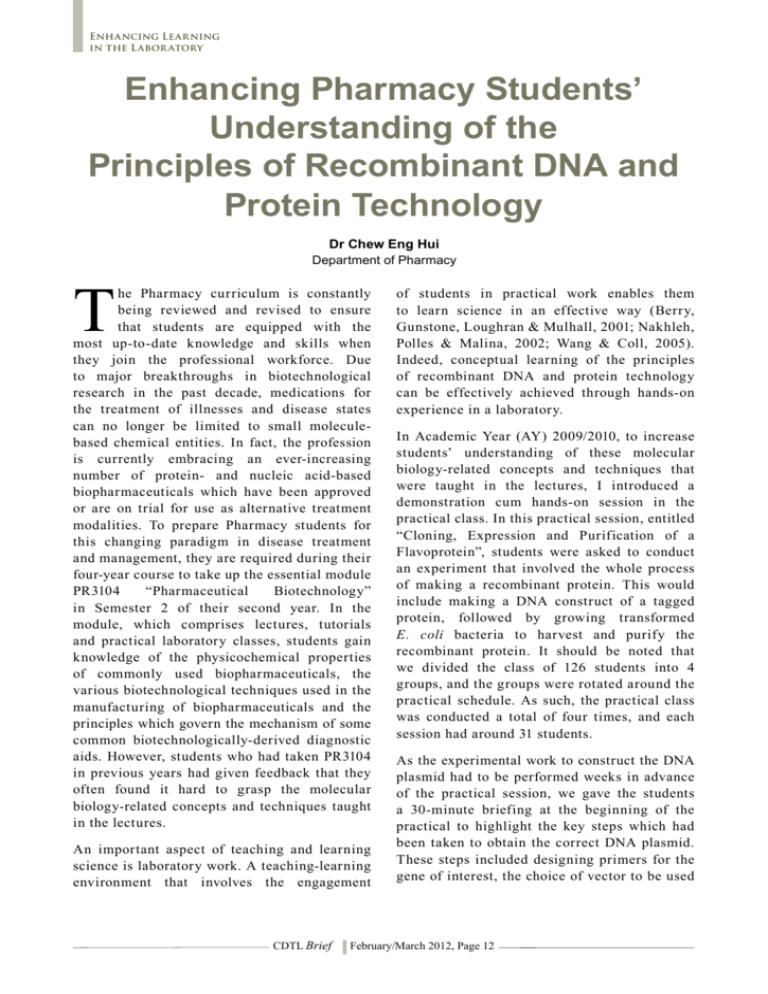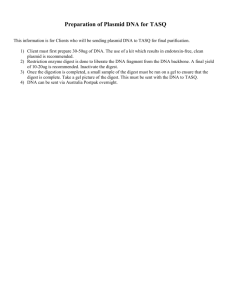reading - CDTL - National University of Singapore
advertisement

Enhancing Learning in the Labor atory Enhancing Pharmacy Students’ Understanding of the Principles of Recombinant DNA and Protein Technology Dr Chew Eng Hui T Department of Pharmacy he Pharmacy curriculum is constantly being reviewed and revised to ensure that students are equipped with the most up-to-date knowledge and skills when they join the professional workforce. Due to major breakthroughs in biotechnological research in the past decade, medications for the treatment of illnesses and disease states can no longer be limited to small moleculebased chemical entities. In fact, the profession is currently embracing an ever-increasing number of protein- and nucleic acid-based biopharmaceuticals which have been approved or are on trial for use as alternative treatment modalities. To prepare Pharmacy students for this changing paradigm in disease treatment and management, they are required during their four-year course to take up the essential module PR3104 “Pharmaceutical Biotechnology” in Semester 2 of their second year. In the module, which comprises lectures, tutorials and practical laboratory classes, students gain knowledge of the physicochemical properties of commonly used biopharmaceuticals, the various biotechnological techniques used in the manufacturing of biopharmaceuticals and the principles which govern the mechanism of some common biotechnologically-derived diagnostic aids. However, students who had taken PR3104 in previous years had given feedback that they often found it hard to grasp the molecular biology-related concepts and techniques taught in the lectures. An important aspect of teaching and learning science is laboratory work. A teaching-learning environment that involves the engagement CDTL Brief of students in practical work enables them to learn science in an effective way (Berry, Gunstone, Loughran & Mulhall, 2001; Nakhleh, Polles & Malina, 2002; Wang & Coll, 2005). Indeed, conceptual learning of the principles of recombinant DNA and protein technology can be effectively achieved through hands-on experience in a laboratory. In Academic Year (AY) 2009/2010, to increase students’ understanding of these molecular biology-related concepts and techniques that were taught in the lectures, I introduced a demonstration cum hands-on session in the practical class. In this practical session, entitled “Cloning, Expression and Purification of a Flavoprotein”, students were asked to conduct an experiment that involved the whole process of making a recombinant protein. This would include making a DNA construct of a tagged protein, followed by growing transformed E. coli bacteria to harvest and purify the recombinant protein. It should be noted that we divided the class of 126 students into 4 groups, and the groups were rotated around the practical schedule. As such, the practical class was conducted a total of four times, and each session had around 31 students. As the experimental work to construct the DNA plasmid had to be performed weeks in advance of the practical session, we gave the students a 30-minute briefing at the beginning of the practical to highlight the key steps which had been taken to obtain the correct DNA plasmid. These steps included designing primers for the gene of interest, the choice of vector to be used February/March 2012, Page 12 Enhancing Learning in the Labor atory for gene insertion and how to read a vector map, the polymerase chain reaction (PCR) conducted to clone the gene of interest carrying the desired restriction sites, as well as the final ligation of the cloned DNA insert into a restricted vector plasmid. The briefing was followed by the demonstration cum hands-on practical session that lasted approximately two-and-a-half hours. Students were split into groups of 10 to 12, where each group was guided through the practical session by a demonstrator. The demonstrator team comprised a lab technologist, a graduate student as teaching assistant, and myself. My team members had already been given a prior briefing and training session by me to ensure that all three of us provided the same level of scientific guidance to the students. To reinforce the theories of gene cloning discussed during the briefing, students were asked to digest the DNA plasmid with restriction enzymes, followed by the separation of the digested contents by agarose gel electrophoresis and the final illumination of the nucleic acids using ultraviolet excitation. The visualisation of the cut DNA insert on the agarose gel would allow for easier understanding of the need for restriction sites to be included in the cloned gene for insertion into the vector. During the practical, students were also instructed to purify the recombinant protein produced by transformed E. coli bacterial culture through the use of a series of phosphate buffers with varying eluting salt concentrations. To arouse students’ interest and instill a stronger visual understanding of the process, a yellow f lavoprotein (due to the presence of a prosthetic FAD cofactor bound to the protein) instead of a colourless protein was chosen to be produced in the experiment. At the end of the practical session, as a measure of students’ learning outcomes, each student had to prepare a lab report to showcase their understanding of the common molecular biology-related concepts and techniques covered in PR3104. The content to be included in the lab report comprised three parts. For Part (A) “Design and making of pET41HisAIF(121) DNA construct”, the concepts and principles had been discussed in lectures, tutorials, as well as during the briefing at the start of the practical. Students were required to summarise their knowledge by applying the known approaches and techniques in a written format on the lab report. For Part (B) “Digestion of DNA plasmid with restriction enzymes”, students were asked to interpret the results of an illuminated agarose gel image showing DNA bands of digested and undigested plasmids (see Figure 1). Figure 1. An illuminated agarose gel image. The lanes labeled 1to 3 on the gel image refer to: the DNA ladder (Lane 1), digested plasmids (Lane 2) and undigested plasmids (Lane 3). The objective of Part (B) in the lab report was to stimulate students to develop independent thinking skills based on the properties of DNA and the principles of DNA cloning, as well as encourage them to conduct selfdirected learning through further reading up on textbooks and other references. For Part (C) “Bacterial culture, bacterial pellet harvesting and protein isolation/purification”, students had to discuss the rationale and principle of protein purification of the Histidine-tagged (Histagged) recombinant protein. The principle of His-tagged protein purification had not been covered in the lectures, but it could be considered a form of affinity column chromatographic protein purification, a topic that had been covered in the lecture. The objective of Part (C) of the lab report was to encourage students to reveal the principle underlying His-tagged continued on the next page... CDTL Brief February/March 2012, Page 13 Enhancing Learning in the Labor atory protein purification and to draw inferences to a practical and common example of affinity column chromatographic protein purification. The students’ lab reports had been read by the instructors and any clarifications which were required in relation to misinterpreted molecular biology and protein purification concepts had been penned in the reports. These reports were returned to the students before their exams. From the content of the reports, it could be concluded that students generally understood the various cloning steps in molecular biology. A common misinterpretation was the differential use of the two origins of replication within the plasmid vector, which had been clarified in the feedback comments to the students. For Part (B) of the lab report, students did well in correctly interpreting the results on the illuminated agarose gel image. Similarly, for Part (C) of the report, students were generally able to understand the principles of affinity column chromatographic protein purification and the crucial role buffers of different salt concentrations could play in the entire protein purification process. The lab reports also included positive remarks to the students; these served as a form of encouragement as well as a vote of confidence to the students that their self-directed learning had resulted in positive outcomes. When we returned the marked lab reports to the students, a written survey was conducted to ascertain their responses and attitudes after experiencing this approach. 90% of the 109 students who responded found the demonstration cum hands-on practical session useful in allowing them to gain a better understanding of the concepts of molecular cloning and protein purification. Students had also voted which part(s) of the practical session they found helpful in enhancing their understanding of concepts; the findings were tabulated in Table 1. Table 1. Parts of the practical session which students found helpful in enhancing their understanding of concepts Parts of the Practical Session No. of Votes by Students* The briefing 3 The entire hands-on experience 15 The handouts/notes 5 The vector map 12 Primer design 17 6 x Histidine tag 14 The yellow protein 6 Use of different buffers 14 Chromatographic elution of protein 13 Laboratory report 8 All (the whole practical session + laboratory report) 15 *The votes indicate which parts of the lab session they found useful in helping them gain a better understanding of the concepts. CDTL Brief February/March 2012, Page 14 Enhancing Pharmacy Students’ Understanding of the Principles of Recombinant DNA & Protein Technology ... continued from pg 14 In summary, the demonstration cum hands-on practical session effectively complemented the in-class lectures by allowing students to comprehend with greater clarity the concepts which govern molecular biology. Practical laboratory work is an active learning activity. By adopting a hands-on approach to go through the entire process of making a recombinant protein, the practical session not only enhanced students’ understanding of recombinant DNA and protein technology, but also exposed them to the real-life practical applications of biotechnology. References Berry, A., Gunstone, R., Loughran, J. & Mulhall, P. (2001). Using laboratory work for purposeful learning about the practice of science. In H. Behrendt et al. (Eds.), Research in Science Education—Past, Present, and Future, pp. 313-318. Dordrecht; Boston, Mass.: Kluwer Academic Publishers. Nakhleh, M.B., Polles, J. & Malina, E. (2002). Learning chemistry in a laboratory environment. In J.K. Gilbert et al. (Eds.), Chemical Education: Towards Research-based Practice, pp. 6994. Netherlands: Kluwer Academic Publishers. Wang, W. & Coll, R.K. (2005.) An investigation of tertiary-level learning in some practical physics courses. International Journal of Science and Mathematics Education, 3(4), pp. 639669. CDTL The Centre for Development of Teaching and Learning (CDTL) engages in a wide range of activities to promote good teaching and learning at the National University of Singapore, including professional development, teaching and learning support, research on educational issues, and instructional design and development. contributors So Wing Chee Thian Eng San Christine Teng Aaron Danner Chew Eng Hui advisors Chng Huang Hoon Lakshminarayanan Samavedham Alan Soong editors Liew Shin Dee Alan Soong layout Ma Lin Lin © 2012 CDTL Brief is published by the Centre for Development of Teaching and Learning. Reproduction in whole or in part of any material in this publication without the written permission of CDTL is expressly prohibited. The views expressed or implied in CDTL Brief do not necessarily reflect the views of CDTL. CDTL Brief is available on http://www.cdtl.nus.edu.sg/brief/ Comments, suggestions and contributions should be addressed to: The Editor, CDTL Brief Centre for Development of Teaching and Learning Central Library Annexe, Level 6 National University of Singapore 10 Kent Ridge Crescent Singapore 119260 Tel: (65) 6516-2071 Fax: (65) 6777-0342 Email: cdtpost@nus.edu.sg CDTL Brief / February 2012, Page 15






